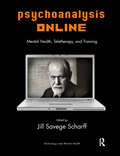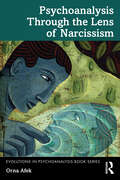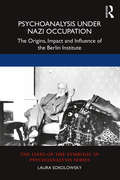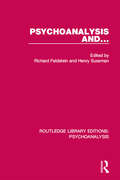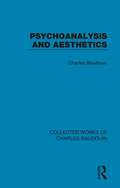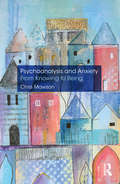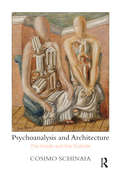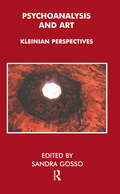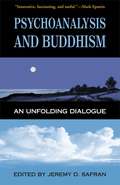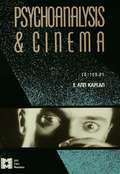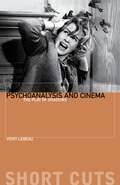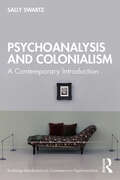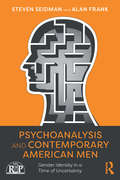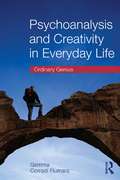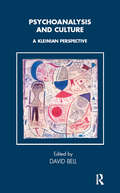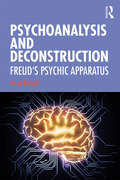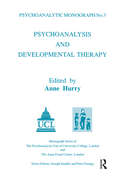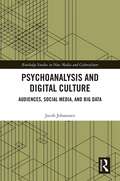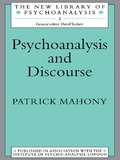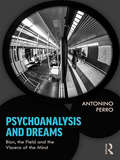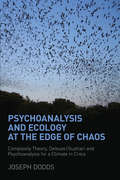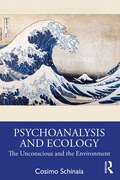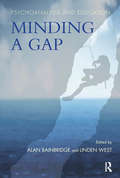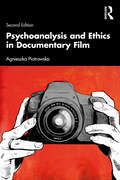- Table View
- List View
Psychoanalysis Online: Mental Health, Teletherapy, and Training (The\library Of Technology And Mental Health Ser.)
by Jill Savege ScharffThis book is about teleanalysis, an exploration of teletherapy—psychotherapy by telephone, Voice over Internet Protocol (VoIP), or videoteleconference (VTC). It discusses advantages and disadvantages of psychotherapy and psychoanalysis conducted over the phone and internet.
Psychoanalysis Through the Lens of Narcissism (Evolutions in Psychoanalysis Book Series)
by Orna AfekThis critical historical review of psychoanalytic theory and practice reflects on the place of psychoanalysis in contemporary Western culture in light of its preoccupation with the self and associated failure to emphasize the role of close interpersonal relationships as central to the human psyche.The elusive presence of the separate other in psychoanalytic theory is discussed vis-à-vis the life stories of Freud, Winnicott, and Kohut. The underlying narcissistic bias in the theories of these three pioneers of psychoanalysis – classical Freudian drive theory, Winnicott’s theory of the parent-infant relationship, and Kohut's theory of self-psychology – is traced back to their narcissistic personality traits, which impacted their views and perceptions and obscured the fundamental centrality of interpersonal relationships per se in the inner world of the individual, with far-reaching implications for psychoanalytic thought and practice.With fresh insights on the subjectivity of personality theories, the core features of the narcissistic personality, and the implications of the narcissistic position for theory and clinical practice, this book will interest psychotherapists, psychoanalysts, and other professionals in the field, specifically those interested in personality diagnosis, narcissism, attachment theory, and psychotherapeutic approaches and psychoanalytic theories in general.
Psychoanalysis Under Nazi Occupation: The Origins, Impact and Influence of the Berlin Institute
by Laura SokolowskyLaura Sokolowsky’s survey of psychoanalysis under Weimar and Nazism explores how the paradigm of a ‘psychoanalysis for all’ became untenable as the Nazis rose to power. Mainly discussing the evolution of the Berlin Institute during the period between Freud’s creation of free psychoanalytic centres after the founding of the Weimar Republic and the Nazi seizure of power in 1933, the book explores the ideal of making psychoanalysis available to the population of a shattered country after World War I, and charts how the Institute later came under Nazi control following the segregation and dismissal of Jewish colleagues in the late 1930s. The book shows how Freudian standards resisted the medicalisation of psychoanalysis for purposes of adaptation and normalisation, but also follows Freud’s distinction between sacrifice (where you know what you have given up) and concession (an abandonment of position through compromise) to demonstrate how German psychoanalysts put themselves at the service of the fascist master, in the hope of obtaining official recognition and material rewards. Discussing the relations of psychoanalysis with politics and ethics, as well as the origin of the Lacanian movement as a response to the institutionalisation of psychoanalysis during the Nazi occupation, this book is fascinating reading for scholars and practitioners of psychoanalysis working today.
Psychoanalysis and ...: The Sublime And The Grandiose In Literature, Psychopathology, And Culture (Routledge Library Editions: Psychoanalysis)
by Henry Sussman Richard FeldsteinOriginally published in 1990, Psychoanalysis and… brings together essays by critics whose work demonstrates the lively interpenetration of psychoanalysis and other disciplines. Andrew Ross investigates psychoanalysis and Marxist thought; Joel Fineman reads the "sound of O" in Othello; Jane Gallop asks "Why does Freud giggle when the women leave the room?"; and Ellie Ragland-Sullivan examines Lacan’s seminars on James Joyce. This stimulating collection of work should still be required reading, especially for students of literature. But Psychoanalysis and… demonstrates that psychoanalysis – and theoretical criticism, and feminism, and Lacanian theory, and semiotics, and Marxism, and deconstruction, and literary criticism – was, at the time, a rich and expanding terrain.
Psychoanalysis and Aesthetics (Collected Works of Charles Baudouin)
by Charles BaudouinOriginally published in 1924, this title is substantially a continuation of Baudouin’s earlier work Studies in Psychoanalysis, being an application of psychoanalysis to the theory of aesthetics, as illustrated by a detailed study of the works of the Belgian poet Emile Verhaeren. The ‘interpretation’ Freud has supplied for dreams Baudouin attempts – and archives – for the imagery of the artistic creator. The work is in part based upon private documents supplied to the author by Madame Verhaeren, an autograph letter, and a previously unpublished poem.
Psychoanalysis and Anxiety: From Knowing to Being
by Chris MawsonPsychoanalysis and Anxiety: From Knowing to Being combines psychoanalytic, existential and dramaturgical perspectives on the study of anxiety. The book explores the implications for psychoanalysis of including a consideration of the being of the patient, and of the analyst. The central principle throughout is that the psychoanalytic and the existential belong together since it is the irreducible fact of anxiety that unifies them. It is in relation to anxiety that we are helped by other human beings to bear what is, and what we are. Divided into four sections, the book begins with the distinction made in antiquity between anxiety and fear, before discussing its treatment by philosophers such as Heidegger, who regarded anxiety as the mood most disclosive of our being, and Kierkegaard, who distinguished between fear and angst. The book then explores how anxiety has been understood by major psychoanalytic theorists, including Freud, Klein, Winnicott and Bion, before a third part discusses how key principles of drama relate to therapeutic practice and theory, including a re-evaluation of the concept of catharsis, as well as Brecht’s concept of making strange the familiar. The pursuit of insightful knowledge in psychoanalysis is reconsidered in the book’s concluding section, with a shift of emphasis from psychoanalytic interpretations as statements of knowing to interpretive activity as a continuous process of becoming informed. This insightful and wide-ranging volume will fascinate practising psychoanalysts and psychotherapists, anyone working in mental health, as well as scholars of philosophy and theatre.
Psychoanalysis and Architecture: The Inside and the Outside
by Cosimo SchinaiaThis book explores how psychoanalysis and architecture can enhance and increase the chances of mental 'containment', while also fostering exchange between inside and outside. The way in which psychoanalysts take care of mental suffering, and the way in which architects and city planners assess the environment, are grounded in a shared concern with the notion of 'dwelling'. It is a matter of fact that dwelling exists in a complex context comprised of both biological need and symbolic function. Psychoanalysis and architecture can work together in both thinking about and designing not only our homes but also the analyst's consulting rooms and, more generally, our therapy places. However, this is possible only if they renounce the current limited and restrictive model of this interaction, and propose one more that is more in harmony with the questions and situations that clients themselves pose.
Psychoanalysis and Art: Kleinian Perspectives
by Donald MeltzerThis essential edition brings together a collection of classic papers from key figures in Kleinian and post-Kleinian thought that explore the relationship between psychoanalysis and art.Sandra Gosso begins with a comprehensive and fascinating guide to the history of this relationship which began with Freud and was developed further by Melanie Klein at a time when most analysts were moving away from links with art. Melanie Klein's pivotal paper, "Infantile Anxiety Situations Reflected in a Work of Art and in the Creative Impulse", follows the Introduction. The other papers featured are mainly from British analysts who expanded on Melanie Klein's ideas, inspired by the influence of the creative Bloomsbury and Imago Groups.
Psychoanalysis and Buddhism
by Jeremy D. Safran"What a wonderful book! Jeremy Safran has assembled an absolutely stellar group of writers and has himself contributed an illuminating introduction. The essays are riveting and the book is the rare edited collection with real thematic unity. If you think you might have an interest in the intersection of psychoanalysis and Buddhism, this is the place to start. If you already know you're interested, once you look at the table of contents you'll find (at least I did) that you want to let Psychoanalysis and Buddhism displace whatever you were going to read next."--Donnel B. Stern, PhD, author of Unformulated Experience and editor of Contemporary Psychoanalysis
Psychoanalysis and Cinema (AFI Film Readers)
by E. Ann KaplanThese fifteen carefully chosen essays by well-known scholars demonstrate the vitality and variety of psychoanalytic film criticism, as well as the crucial role feminist theory has played in its development. Among the films discussed are Duel in the Sun, The Best Years of Our Lives, Three Faces of Eve, Tender is the Night, Pandora's Box, Secrets of the Soul, and the works of Jacques Tourneur (director of The Cat People and other features).
Psychoanalysis and Cinema: The Play of Shadows (Short Cuts)
by Vicky LebeauLebeau examines the long and uneven history of developments in modern art, science, and technology that brought pychoanalysis and the cinema together towards the end of the nineteenth century. She explores the subsequent encounters between the two: the seductions of psychoanalysis and cinema as converging, though distinct, ways of talking about dream and desire, image and illusion, shock, and sexuality. Beginning with Freud's encounter with the spectacle of hysteria on display in fin-de-siècle Paris, this study offers a detailed reading of the texts and concepts which generated the field of psychoanalytic film theory.
Psychoanalysis and Colonialism: A Contemporary Introduction (Routledge Introductions to Contemporary Psychoanalysis)
by Sally SwartzWithin this important and insightful book, Sally Swartz introduces readers to early entanglements of psychoanalytic theory with colonialism and how it has led to significant and long-lasting implications for psychoanalysis. Psychoanalysis and Colonialism is unique in drawing together a wide array of sources and a span of history from the beginnings of psychoanalysis to current theory and practice. The book explores ways in which Freudian theory incorporated the idea of the primitive into the centre of mapping the untamed territories of the unconscious, via notions of taming instinctual excess, civilizing the primitive and conquering and bringing order to wildness. The text describes the influences of colonialism on the thinking of Freud and Jung and goes on to describe anti-colonial voices, including Césaire and Mannoni, Memmi and Fanon, and their contribution to psychoanalytic theory. It concludes with thoughts on the challenges of decolonizing psychoanalysis. This book is an accessible account of the links between colonialism and psychoanalysis and is suitable for general readers with an interest in the topic, as well as all psychoanalytic practitioners grappling with the ways in which issues of race, class, gender and sexuality affect their ways of working and writing.
Psychoanalysis and Contemporary American Men: Gender Identity in a Time of Uncertainty (Relational Perspectives Book Series)
by Steven Seidman Alan FrankDebate over gender and especially the lives of men is currently at a fever pitch, particularly in the United States. New perspectives that capture the complexity of men and a rapidly changing gender landscape are therefore critical today. Psychoanalysis and Contemporary American Men challenges narrow stereotyped views of men by arguing that men are as complex and layered as women. In the light of the recent #MeToo movement, stereotypes of men are being recycled. While aligned with the spirit of this movement, the authors worry that negative stereotypes of men are being perpetrated at the very time that men are renegotiating their gender experience. The authors present a critical non-heteronormative perspective addressing current gender transformations. Although the lives of men are changing, the stories that dominate the public sphere often represent them as narrowly phallic—controlling, detached, sexist, and homophobic. Seidman and Frank offer a counter point: men are also "guardians" driven to be useful and to do good, to live valued and purposeful lives. They argue that men are not only driven by a will to power but by an ethically-minded, relationally-oriented sense of responsibility to care for others, whether partners, children, or fellow citizens. Drawing on historical, sociological, and psychoanalytic work, this book provides a nuanced, multidimensional construct of American men today. Psychoanalysis and Contemporary American Men will be of interest to psychoanalysts and psychotherapists as well as scholars and students of gender and queer studies.
Psychoanalysis and Creativity in Everyday Life: Ordinary Genius
by Gemma Corradi FiumaraPsychoanalysis and Creativity in Everyday Life: Ordinary Genius is an attempt to create a psychoanalytic space for the quest and questions of our everyday creativity. Official creativity is normally applauded to the point of obscuring all other types of creativity, with detrimental consequences for our psychic life. However, as Gemma Corradi Fiumara demonstrates, the creative force of ordinary subjects can be as vigorous as that of our acclaimed, official accomplishments. Corradi Fiumara focuses on the unsung creativity which emerges from relationships and the world at large. She explores how understanding the operation of creative impulses in an everyday setting can crucially inform psychoanalytic clinical work. There are three main themes: Donald Winnicott’s Psychoanalytic Will Melanie Klein and the Other Side of Genius Genius: Ordinary and Extraordinary. Psychoanalysis and Creativity in Everyday Life advocates an inclusionary view of human genius, and demonstrates that creativity and genius can be manifested in everyday life with the ordinary as its focus of attention. It will be key reading for psychoanalysts, psychoanalytic psychotherapists, philosophers and scholars in social studies.
Psychoanalysis and Culture: A Kleinian Perspective (Tavistock Clinic Series)
by David BellThis book provides an extensive introduction and theoretical background to the field, situating psychoanalysis itself in contemporary culture. It shows the relevance of psychoanalysis beyond the consulting room to the understanding of human affairs in general.
Psychoanalysis and Deconstruction: Freud's Psychic Apparatus
by Jared RussellPsychoanalysis and Deconstruction: Freud's Psychic Apparatus demonstrates the relevance of deconstructive thinking for the clinical practice of psychoanalysis. Arguing that deconstruction has been misrepresented as a form of literary theory or a philosophy of language, the book puts Derrida, Heidegger and others working in the tradition of deconstruction into dialogue with debates in the contemporary psychoanalytic field. Attempting to retrieve what was radical in Freud’s portrayal of the mind as a machine, Jared Russell stresses the importance of psychoanalysis for an understanding of the relationship between the human and its current hyper-technological environment. Interventions into contemporary debates address psychoanalytic concepts such as the nature of the clinical frame, the intersubjective dialogue, unconscious communication and the experience of time. Russell argues that deconstruction, and in particular Derrida’s work, can anticipate and help clarify ongoing developments at the cutting edge of psychoanalysis today. Psychoanalysis and Deconstruction: Freud's Psychic Apparatus will appeal not only to a philosophically informed audience but also to clinicians attempting to secure a place for psychoanalytic practice at the beginning of the twenty-first century.
Psychoanalysis and Developmental Therapy (The Psychoanalytic Monograph Series)
by Anne HurryThis book exemplifies a special kind of application of psychoanalysis. It shows how the child uses the analyst both as a transference object and as a new developmental object, illustrating the mutually enabling and inextricably interwoven nature of developmental work and interpretation of conflict.
Psychoanalysis and Digital Culture: Audiences, Social Media, and Big Data (Routledge Studies in New Media and Cyberculture)
by Jacob JohanssenPsychoanalysis and Digital Culture offers a comprehensive account of our contemporary media environment—digital culture and audiences in particular—by drawing on psychoanalysis and media studies frameworks. It provides an introduction to the psychoanalytic affect theories of Sigmund Freud and Didier Anzieu and applies them theoretically and methodologically in a number of case studies. Johanssen argues that digital media fundamentally shape our subjectivities on affective and unconscious levels, and he critically analyses phenomena such as television viewing, Twitter use, affective labour on social media, and data-mining. How does watching television involve the body? Why are we so drawn to reality television? Why do we share certain things on social media and not others? How are bodies represented on social media? How do big data and data mining influence our identities? Can algorithms help us make better decisions? These questions amongst others are addressed in the chapters of this wide-ranging book. Johanssen shows in a number of case studies how a psychoanalytic angle can bring new insights to audience studies and digital media research more generally. From audience research with viewers of the reality television show Embarrassing Bodies and how they unconsciously used it to work through feelings about their own bodies, to a critical engagement with Hardt and Negri's notion of affective labour and how individuals with bodily differences used social media for their own affective-digital labour, the book suggests that an understanding of affect based on Freud and Anzieu is helpful when thinking about media use. The monograph also discusses the perverse implications of algorithms, big data and data mining for subjectivities. In drawing on empirical data and examples throughout, Johanssen presents a compelling analysis of our contemporary media environment.
Psychoanalysis and Discourse (New Library of Psychoanalysis)
by Patrick MahonyAfter a detailed discussion of the significance of translation as a critical concept in psychoanalysis, Patrick Mahony proceeds to a comprehensive examination of 'free association', the cornerstone of psychoanalytic method. Next follows the consideration of free association in its relation to scientific rhetorical, expressive and literary discourse. Mahony then begins a detailed study of certain aspects of the text of Freud's Interpretation of Dreams and of issues involved in the oral reporting of dreams. Attention is subsequently turned to the analysis of Freud's own writing in general, and specifically to Totem and Taboo. Finally, the author shows how his ideas can illuminate literary classics (by Villon, Shakespeare, Kafka, and Jonson) and the debate about whether there is anything specific to women's discourse.
Psychoanalysis and Dreams: Bion, the Field and the Viscera of the Mind
by Antonino FerroPsychoanalysis and Dreams explores some of the cornerstones of Antonino Ferro’s theoretical model but also attempts to extend the dreamlike boundaries of the model. Based on Bion’s theory of alpha function and the analytic field, Ferro has developed his own original theorization of transformations in dreams and of work in the analytic session as a waking dream. Clearly highlighted in the book is Ferro’s theory that transformation in dreams is the activity which is constantly carried out in the mind of the analyst, who nullifies the reality-status of the patient’s communication and considers the patient’s narrative as a dream which must be constructed in real time in the encounter between the two minds at work. At the centre of Ferro's theoretical proposal stands the transition from a psychoanalysis of contents to a psychoanalysis which develops the apparatus for thinking, based on the conception of an unconscious in a perennial state of construction and transformation, which must be dreamed, and which continuously expands as it is dreamed. Psychoanalysis and Dreams is written for practicing and training psychoanalysts, psychotherapists and psychiatrists and will be helpful in everyday psychoanalytic and psychotherapeutic work.
Psychoanalysis and Ecology at the Edge of Chaos: Complexity Theory, Deleuze,Guattari and Psychoanalysis for a Climate in Crisis
by Joseph DoddsThis book argues that psychoanalysis has a unique role to play in the climate change debate through its placing emphasis on the unconscious dimensions of our mental and social lives. Exploring contributions from Freudian, Kleinian, Object Relations, Self Psychology, Jungian, and Lacanian traditions, the book discusses how psychoanalysis can help to unmask the anxieties, deficits, conflicts, phantasies and defences crucial in understanding the human dimension of the ecological crisis. Yet despite being essential to studying environmentalism and its discontents, psychoanalysis still remains largely a 'psychology without ecology.' The philosophy of Deleuze and Guattari, combined with new developments in the sciences of complexity, help us to build upon the best of these perspectives, providing a framework able to integrate Guattari's 'three ecologies' of mind, nature and society. This book thus constitutes a timely attempt to contribute towards a critical dialogue between psychoanalysis and ecology. Further topics of discussion include: ecopsychology and the greening of psychotherapy our ambivalent relationship to nature and the non-human complexity theory in psychoanalysis and ecology defence mechanisms against eco-anxiety and eco-grief Deleuze|Guattari and the three ecologies becoming-animal in horror and eco-apocalypse in science fiction films nonlinear ecopsychoanalysis. In our era of anxiety, denial, paranoia, apathy, guilt, hope, and despair in the face of climate change, this book offers a fresh and insightful psychoanalytic perspective on the ecological crisis. As such this book will be of great interest to all those in the fields of psychoanalysis, psychology, philosophy, and ecology, as well as all who are concerned with the global environmental challenges affecting our planet's future.
Psychoanalysis and Ecology: The Unconscious and the Environment
by Cosimo SchinaiaThis book presents the psychoanalyst with the question of how our enormously modified environmental conditions determine our subjective mental changes and vice versa. The gravity of the environmental crisis is amply clear and yet, in the face of such incontrovertible evidence, there is an emotional, more than cognitive, difficulty in comprehending the present reality and its future consequences. In understanding the collective imagination as permeating the individual one and vice versa, this book investigates this relationship of mutual co-determination between the individual traumatic stories told and experienced in the consulting room and the positive or negative environmental attitudes exhibited by patients. The pairing of clinical vignettes with dispatches from the collective imagination sheds light on the confused affective investments and anxieties that propel pathological defenses, such as negation, suppression, intellectualization, displacement, and disavowal. The final chapter concludes with notes on the role of hope in a damaged world and the importance of integrity within the psychoanalytic field and beyond. This book will be of great interest to psychoanalysts, psychotherapists, and psychiatrists, as well as anthropologists, environmentalists, and ecologists.
Psychoanalysis and Education: Minding a Gap
by Linden West Alan BainbridgeThis book provides a unique and highly topical application of psychoanalytic theory to the broad context of education, including schools, universities, and adult learning. Education is understood as a crucial element in a lifelong project to gain more coherent and meaningful understanding of self and others. Psychoanalysis has taken the contingency, construction, and development of human subjectivity, as well as the difficulty of thinking, to be its prime preoccupation. Yet - at a time of increasing doubt and anxiety about the purposes and practice of education - psychoanalytic understanding, from various traditions, has never been more marginal in educational debate. The book seeks, in these terms, to bridge some of this gap: it is written for teachers, trainers, policy-makers, clinicians, researchers, and diverse academics who want to look beyond bland superficialities to deeper struggles for self and understanding. This includes unconscious processes in the relationships that constitue education as well as resistance to new ideas and practices.
Psychoanalysis and Ethics in Documentary Film
by Agnieszka PiotrowskaThis distinctively interdisciplinary approach to the subject encompasses filmmaking, psychoanalysis, philosophy and popular culture and offers a unique insight into documentary film practice from a psychoanalytic perspective. At the heart of the enquiry is belief that ‘transference-love’ is present in the documentary encounter. With a focus on testimony-driven film and a foreword by Michael Renov, who calls this book 'a radical and compelling account', Psychoanalysis and Ethics in Documentary Film covers a range of topics including: Four fundamental concepts of psychoanalysis and documentary film A review of documentary film practice A personal account of the author’s relationship with a subject of her own work A thorough interrogation of the ethics of documentary Ideal for film studies scholars, psychoanalysts, psychotherapists and psychotherapeutically engaged professionals, as well as filmmakers, culture studies students and anyone interested in the process of documentary-making and contemporary culture, this work offers a unique approach.
Psychoanalysis and Ethics in Documentary Film
by Agnieszka PiotrowskaThis distinctively interdisciplinary book draws upon psychoanalytic theory to explore how expectations, desires and fears of documentary subjects and filmmakers are engaged, and the ethical issues that can arise as a result. Original and accessible, the second edition of this ground-breaking book addresses the four fundamental concepts of psychoanalysis and documentary film, reviews documentary film practice as a field, provides a personal account of the author’s relationship with a subject of her own work, and presents a thorough interrogation of the ethics of documentary. The updated text includes a new introduction by the author and an additional chapter ‘Stories We Tell’ by Sarah Polley, centered on ethics and the role of the filmmaker in relation to her participants. Psychoanalysis and Ethics in Documentary Film, 2nd revised edition has already been used widely and is crucial reading for film studies scholars, psychoanalysts, psychotherapists and psychotherapeutically engaged professionals, as well as filmmakers, culture studies students and anyone interested in the process of documentary-making and contemporary culture.
